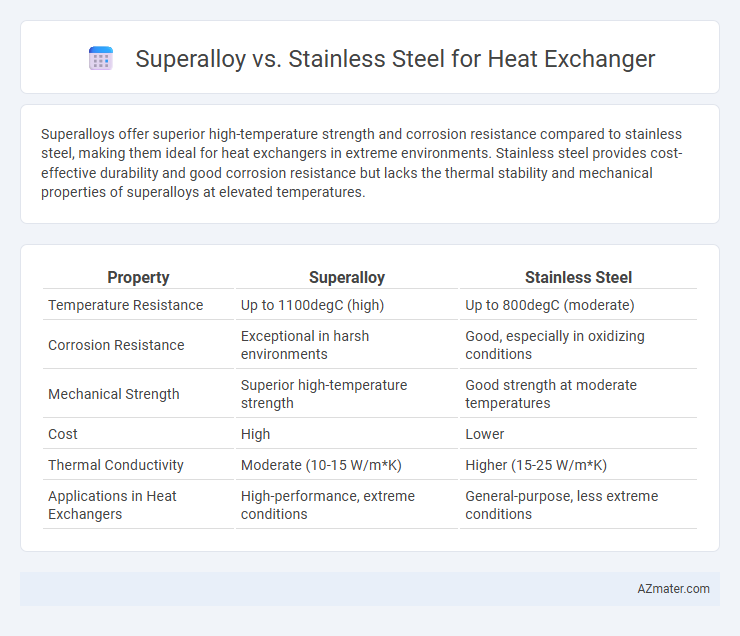Superalloys offer superior high-temperature strength and corrosion resistance compared to stainless steel, making them ideal for heat exchangers in extreme environments. Stainless steel provides cost-effective durability and good corrosion resistance but lacks the thermal stability and mechanical properties of superalloys at elevated temperatures.
Table of Comparison
| Property | Superalloy | Stainless Steel |
|---|---|---|
| Temperature Resistance | Up to 1100degC (high) | Up to 800degC (moderate) |
| Corrosion Resistance | Exceptional in harsh environments | Good, especially in oxidizing conditions |
| Mechanical Strength | Superior high-temperature strength | Good strength at moderate temperatures |
| Cost | High | Lower |
| Thermal Conductivity | Moderate (10-15 W/m*K) | Higher (15-25 W/m*K) |
| Applications in Heat Exchangers | High-performance, extreme conditions | General-purpose, less extreme conditions |
Introduction to Heat Exchanger Materials
Superalloys and stainless steel are key materials used in heat exchangers, chosen for their exceptional corrosion resistance and mechanical strength at high temperatures. Superalloys, typically nickel-based, offer superior performance in extreme environments, making them ideal for aerospace and power generation applications. Stainless steel, often favored for its cost-effectiveness and good thermal conductivity, is widely used in chemical processing and HVAC systems where moderate temperature and corrosion resistance are sufficient.
What Are Superalloys?
Superalloys are high-performance metal alloys primarily composed of nickel, cobalt, or iron, designed to maintain exceptional strength and corrosion resistance at elevated temperatures, making them ideal for demanding applications like heat exchangers. Compared to stainless steel, superalloys exhibit superior oxidation resistance and mechanical stability under thermal stress, enhancing the durability and efficiency of heat exchanger components in high-temperature environments. Their complex microstructure and alloying elements--such as chromium, aluminum, and titanium--enable them to withstand extreme operational conditions better than conventional stainless steels.
Understanding Stainless Steel
Stainless steel, an alloy primarily composed of iron, chromium, and nickel, offers excellent corrosion resistance and moderate strength, making it a popular choice for heat exchangers operating in less extreme environments. Its chromium content forms a passive oxide layer that protects against oxidation and chemical attack, ensuring durability in aqueous and mildly corrosive conditions. Compared to superalloys, stainless steel is more cost-effective and easier to fabricate but may lack the high-temperature strength and oxidation resistance required for advanced heat exchanger applications in harsh industrial settings.
Key Properties: Superalloys vs Stainless Steel
Superalloys exhibit superior high-temperature strength, oxidation resistance, and creep resistance compared to stainless steel, making them ideal for heat exchangers operating under extreme thermal and corrosive environments. Stainless steel offers excellent corrosion resistance and cost-effectiveness but has lower performance in high-temperature and high-stress applications. Key properties such as melting point, tensile strength, and thermal stability distinctly favor superalloys for demanding heat exchanger conditions.
Corrosion Resistance Comparison
Superalloys exhibit superior corrosion resistance compared to stainless steel in heat exchanger applications due to their high content of nickel, cobalt, and chromium, which form stable, protective oxide layers under extreme temperatures and corrosive environments. Stainless steels, particularly grades like 316L, offer good corrosion resistance but are more susceptible to pitting and stress corrosion cracking in highly aggressive media or at elevated temperatures. Selecting superalloys such as Inconel or Hastelloy enhances durability and lifespan of heat exchangers operating under severe thermal and chemical stress.
Temperature Tolerance and Thermal Stability
Superalloys exhibit superior temperature tolerance, maintaining mechanical strength and resistance to oxidation at temperatures exceeding 900degC, whereas stainless steel typically withstands up to around 870degC before degradation. The enhanced thermal stability of superalloys ensures prolonged service life and performance in high-temperature heat exchanger applications, minimizing creep and thermal fatigue. In contrast, stainless steel can suffer from phase instability and reduced corrosion resistance under prolonged exposure to elevated temperatures, limiting its use in extreme thermal environments.
Mechanical Strength and Durability
Superalloys exhibit superior mechanical strength and durability compared to stainless steel in heat exchanger applications, maintaining structural integrity at temperatures exceeding 1000degC. Their enhanced creep resistance and oxidation resistance extend operational lifespan under extreme thermal cycling and corrosive environments. Stainless steel, while cost-effective and corrosion-resistant up to 600-800degC, lacks the high-temperature mechanical robustness required for more demanding and prolonged heat exchanger conditions.
Cost Analysis: Superalloys vs Stainless Steel
Superalloys exhibit superior high-temperature strength and corrosion resistance, making them ideal for heat exchangers in extreme environments but at significantly higher material and fabrication costs compared to stainless steel. Stainless steel offers a more cost-effective solution with adequate performance in moderate temperature and corrosion conditions, resulting in lower initial investment and maintenance expenses. Evaluating total lifecycle cost, including durability and efficiency, is essential when choosing between superalloys and stainless steel for heat exchanger applications.
Industry Applications and Suitability
Superalloys offer superior corrosion resistance, high-temperature strength, and excellent oxidation resistance, making them ideal for heat exchangers in aerospace, chemical processing, and power generation industries where extreme environments prevail. Stainless steel, while more cost-effective and widely used, provides adequate corrosion resistance and durability for heat exchangers in food processing, HVAC, and pharmaceutical applications with moderate thermal and corrosive demands. Choosing between superalloy and stainless steel hinges on the specific industry requirements, such as temperature tolerance, corrosion severity, and budget constraints.
Choosing the Right Material for Your Heat Exchanger
Superalloys offer exceptional high-temperature strength, corrosion resistance, and oxidation resistance, making them ideal for heat exchangers operating in extreme environments like gas turbines and chemical processing. Stainless steel provides excellent corrosion resistance and is cost-effective for moderate temperature applications, commonly used in HVAC and food processing heat exchangers. Selecting the right material depends on factors such as operating temperature, corrosive media, mechanical stress, and budget constraints, ensuring optimal performance and longevity of the heat exchanger.

Infographic: Superalloy vs Stainless steel for Heat exchanger
 azmater.com
azmater.com